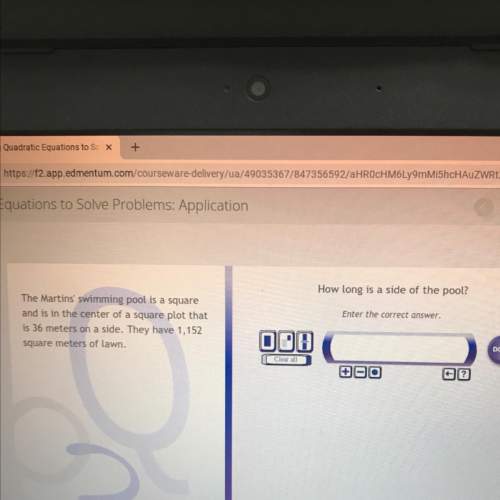
Mathematics, 02.02.2021 01:00 mikemike59
Debra wants to cover a footrest in the shape of a rectangular prism with cotton fabric. The footrest is 14 inches by 9 inches by 9 inches. She has 1 square yard of fabric. Can she completely cover the footrest? Explain. Debra has 1 ydof fabric, which is in2. The footrest has a surface area of in2.

Answers: 3
Another question on Mathematics

Mathematics, 21.06.2019 21:10
Starting at home, emily traveled uphill to the hardware store for 606060 minutes at just 666 mph. she then traveled back home along the same path downhill at a speed of 121212 mph. what is her average speed for the entire trip from home to the hardware store and back?
Answers: 1

Mathematics, 21.06.2019 22:30
Amachine that produces a special type of transistor (a component of computers) has a 2% defective rate. the production is considered a random process where each transistor is independent of the others. (a) what is the probability that the 10th transistor produced is the first with a defect? (b) what is the probability that the machine produces no defective transistors in a batch of 100? (c) on average, how many transistors would you expect to be produced before the first with a defect? what is the standard deviation? (d) another machine that also produces transistors has a 5% defective rate where each transistor is produced independent of the others. on average how many transistors would you expect to be produced with this machine before the first with a defect? what is the standard deviation? (e) based on your answers to parts (c) and (d), how does increasing the probability of an event a↵ect the mean and standard deviation of the wait time until success?
Answers: 3

Mathematics, 21.06.2019 23:10
What is the radius of the cone in the diagram? round your answer to the nearest whole number
Answers: 2

Mathematics, 22.06.2019 03:30
On a certain portion of an experiment, a statistical test result yielded a p-value of 0.21. what can you conclude? 2(0.21) = 0.42 < 0.5; the test is not statistically significant. if the null hypothesis is true, one could expect to get a test statistic at least as extreme as that observed 21% of the time, so the test is not statistically significant. 0.21 > 0.05; the test is statistically significant. if the null hypothesis is true, one could expect to get a test statistic at least as extreme as that observed 79% of the time, so the test is not statistically significant. p = 1 - 0.21 = 0.79 > 0.05; the test is statistically significant.
Answers: 3
You know the right answer?
Debra wants to cover a footrest in the shape of a rectangular prism with cotton fabric. The footrest...
Questions


















Computers and Technology, 07.11.2019 06:31





